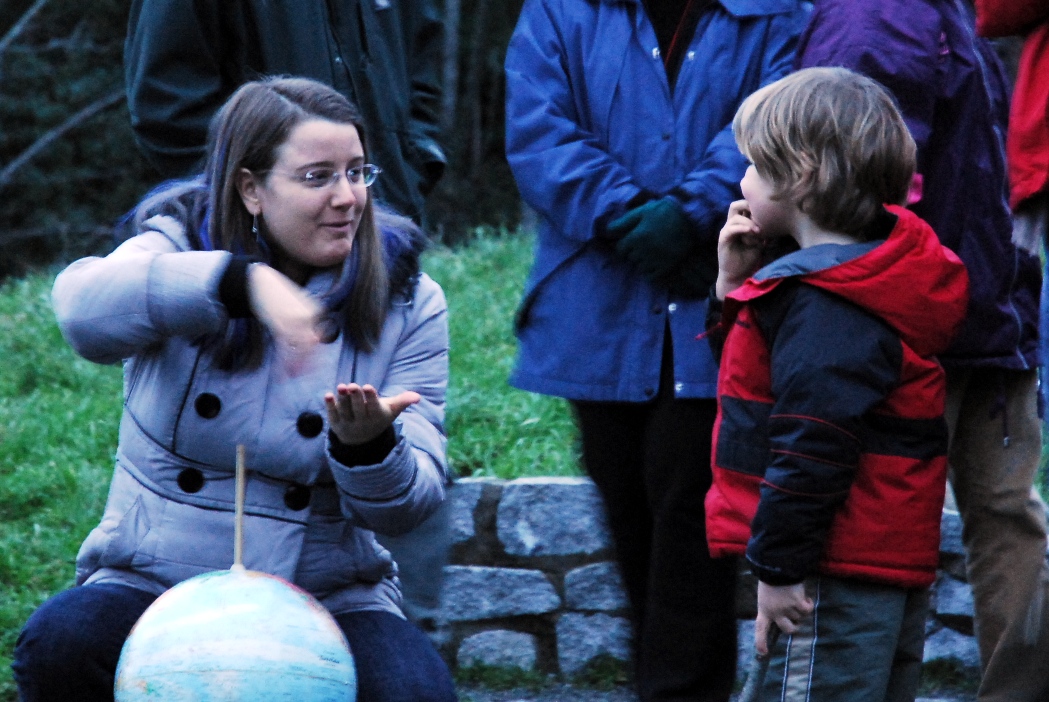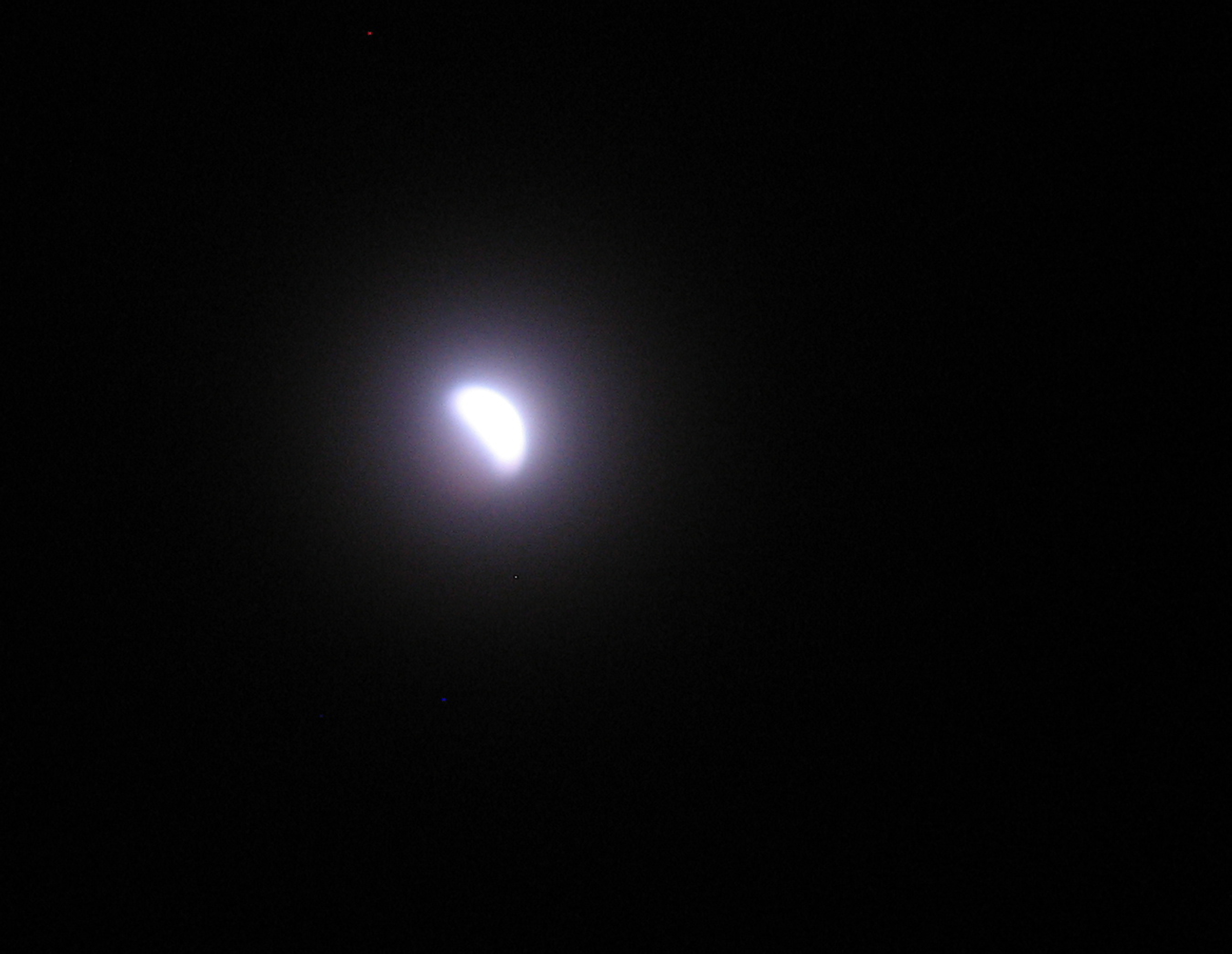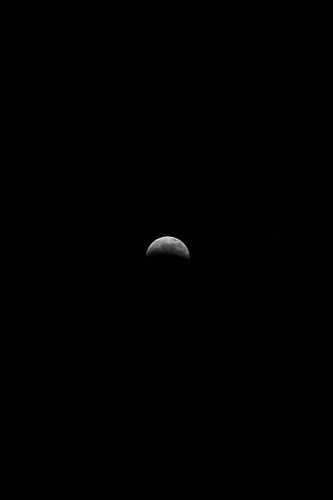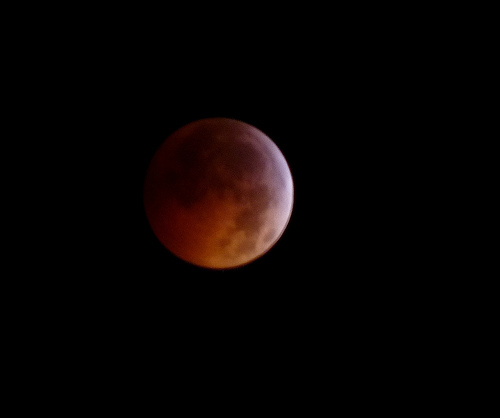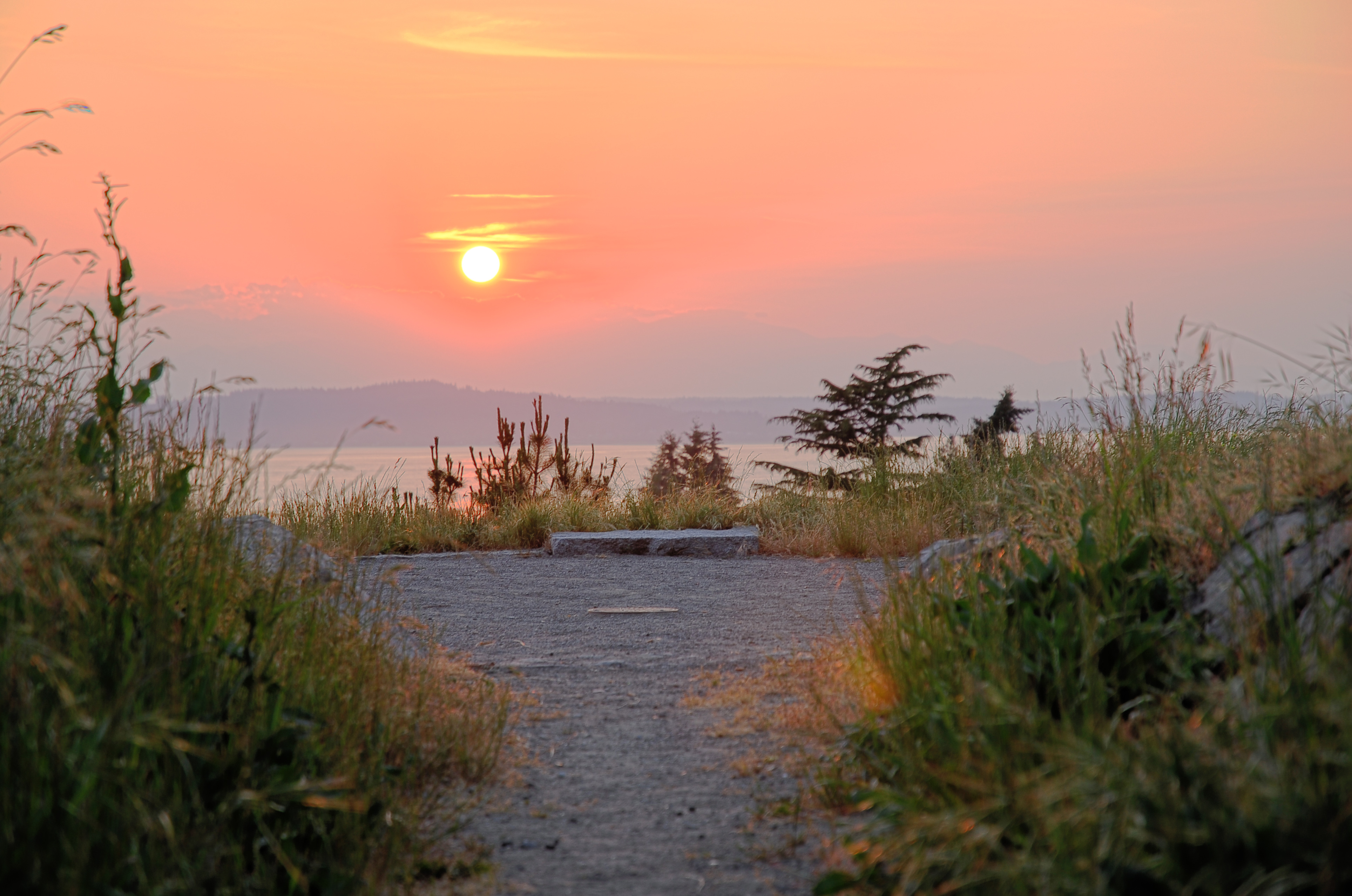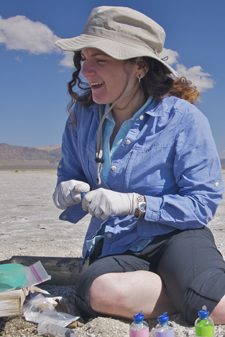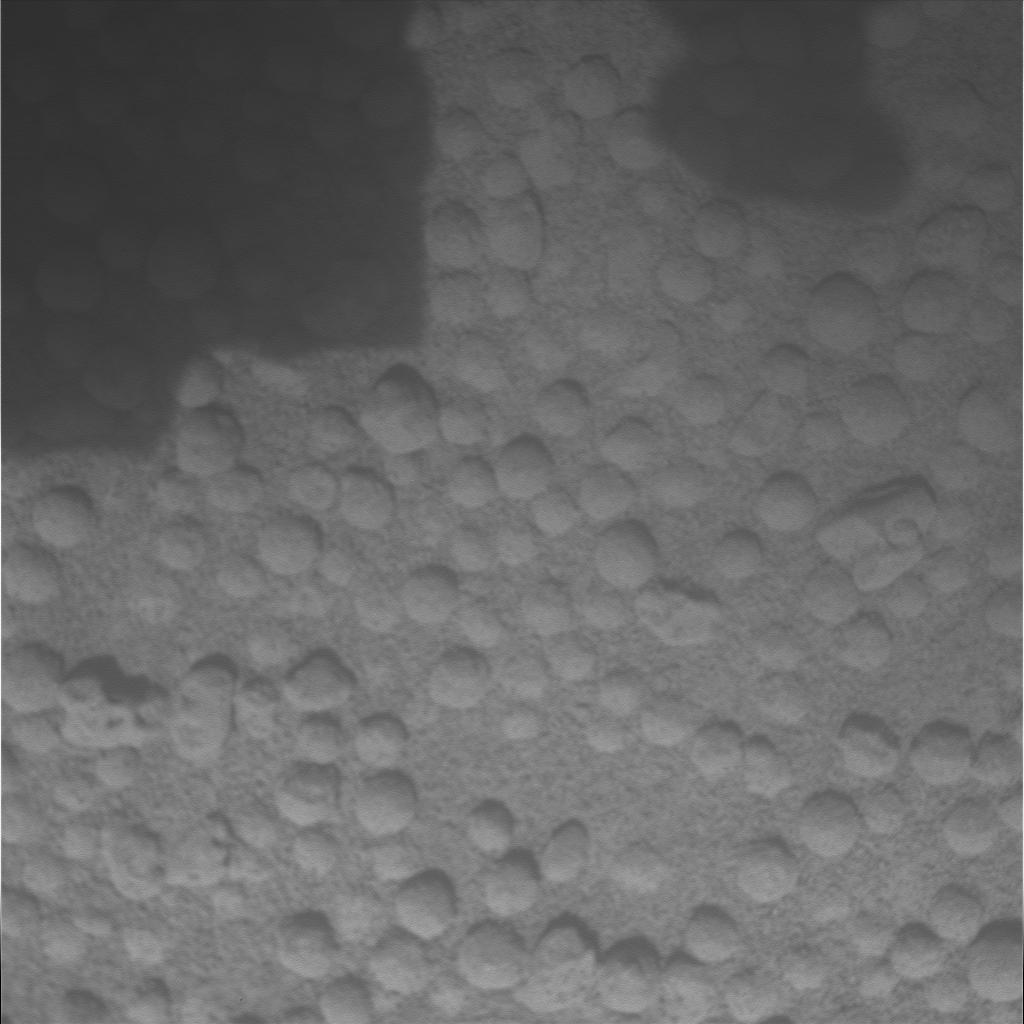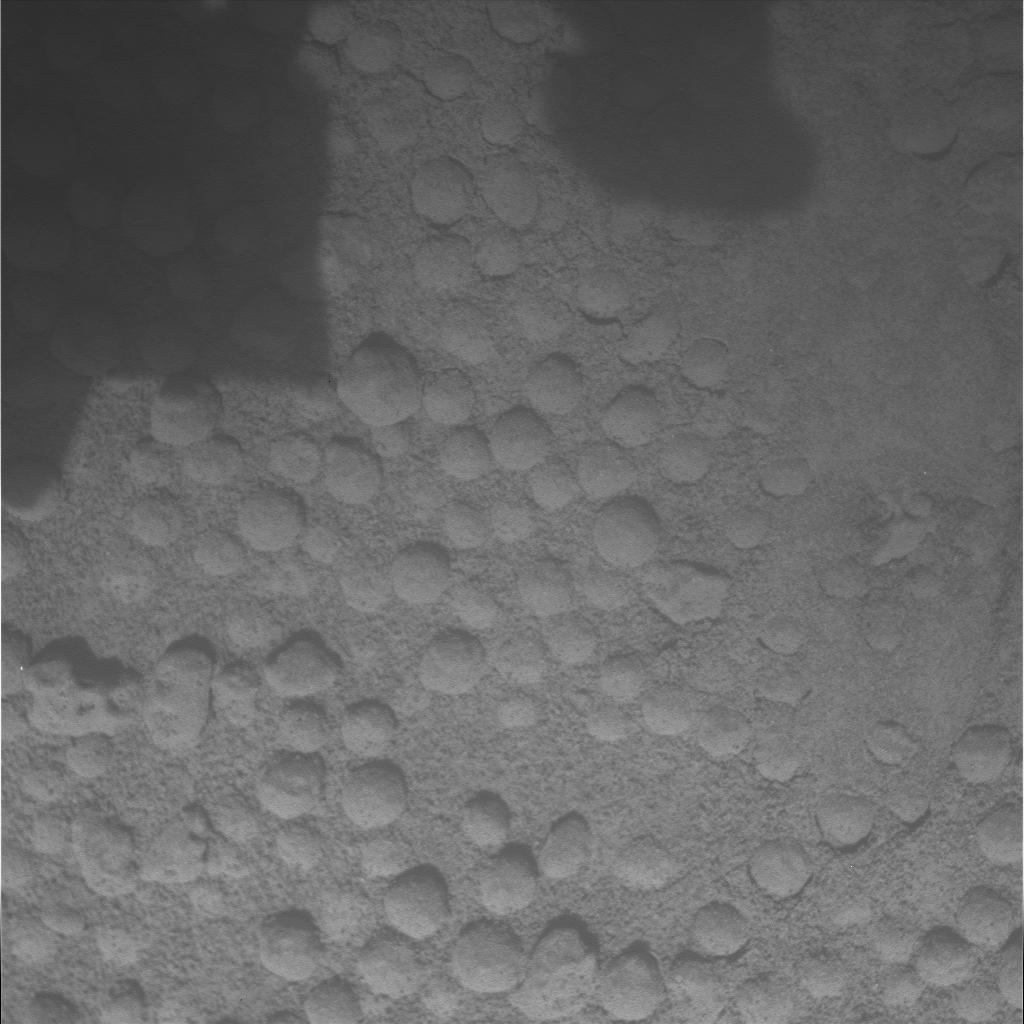Archive for 2010
 Sunset Watch a Success!
Sunset Watch a Success!
You may or may not agree with me, since we saw neither Sun nor sunset, but I had a good time and it seems that everyone in attendance did too.
Coverage of Event
A surprising number of other folks reported on this event as well. For more pictures and description, visit them!
Seattle Times: Jack Broom’s article on the Weather Beat (great pictures!)
West Seattle Blog: Christopher Boffoli covered the solstice-welcoming event just before the sunset watch.
West Seattle Herald: Ty Swenson captured the event with a slide show
I think it’s great that a small community event (generated by solar-system scale alignment) attracted so much attention. I look forward to seeing even more people next time on March 20, 2011.
![]()
~ A l i c e !
 Solstice Lunar Eclipse, 2010 — from Seattle
Solstice Lunar Eclipse, 2010 — from Seattle
Update: Here’s a better picture of the eclipse from Seattle, taken by my husband through one of the tiny thinner spots in the clouds. You can see the signature red color of a total lunar eclipse. I’d say you can see it “distinctly,” because as an astronomer I’d call this “bright red” but I know that the real world calls this “tinged with orange… if you look hard enough.”
In Seattle we have distinct amounts of cloud-cover, not uncommon for this time of year. Despite this, I did see part of the eclipse tonight!
My (not-so-spectacular) photographic proof:
What’s So Special About this Lunar Eclipse?
From my point of view, it’s how long totality lasts – 1 hour and 12 minutes. Most lunar eclipses I’ve seen have less than ten minutes of totality, if any. Hmm, it looks like my estimation of lunar eclipses that I’ve seen is off – they often have 30-60 minute of totality. There’s also the cool coincidence that today (Tuesday the 21st) is also the Winter Solstice for the Northern Hemisphere. Neat.
Better Photos
Here’s a roundup of photos and links to other post-eclipse posts. I’ll update again in the morning, so check back. Updated!
Local
Greg Scheiderer of Seattle Astronomy Examiner has been following the story of the eclipse, and has a picture of the Moon itself from before the eclipse. Update: And this morning he has a post up about his experience here in town.
Update: Joshua Trudjillo of the Seattle P-I caught a surprisingly clear picture of last night’s eclipse. Better than anything else I’ve seen through the clouds. I don’t know how he did it. Joshua, do you have a magic clouds-be-gone spray I should know about?
Update: West Seattle Blog rounded up 3 more clear pictures of the eclipse as it was moving through the partial phases into the total eclipse.
Farther
Update: My friend Rob Sparks in Arizona has some great pictures.
Universe Today will probably have a post later this morning. Update: As I suspected, Universe Today has a great compilation of beautiful images from around the world.
And here are a few for your enjoyment:
Want More?
Mr. Eclipse (Fred Espenak) is the most thorough and accurate cataloger and calculator of eclipses. He also has lots of good photos, diagrams and explanations.
As his site is down right now I’ll temporarily share his diagram of tonight’s eclipse. I can’t look up whether this is fair-use, because I think his site was crashed because of too much traffic. If I can’t confirm that this is okay with him tomorrow morning, I’ll be taking this picture down again.
Update 12/21 noon: I still can’t access his site, so I’m taking the picture down until I can make sure he doesn’t mind.
![]()
~ A l i c e !
 Winter Solstice Sunset Watch – 2010
Winter Solstice Sunset Watch – 2010
- When: Tuesday, December 21, 2010 at 4:20pm (so come at 3:30pm)
- Where: Solstice Park – all the way up the hill from the tennis courts (or, if you’re not in Seattle, wherever you have a view of the western horizon!)
- Who: Everyone welcome, as usual.
Come watch the winter solstice sunset at Solstice Park in West Seattle on Tuesday. We’ll see if the sunset lines up with the placed marker. I’ll be there even if it is cloudy because sometimes the Sun peeks through just as it begins to set, but if it is driving rain or sleet I’m staying home with a cup of tea.
The lunar eclipse will be the night before – early, early Tuesday morning, just after midnight.
If you’re interested – here’s the timing of various celestial events on Saturday from Seattle, courtesy of the U.S. Naval Observatory Astronomical Applications Department:
Sun and Moon Data for One Day
The following information is provided for Seattle, King County, Washington (longitude W122.3, latitude N47.6):
Tuesday 21 December 2010 Pacific Standard Time
SUN
Begin civil twilight 7:19 a.m.
Sunrise 7:55 a.m.
Sun transit 12:08 p.m.
Sunset 4:20 p.m.
End civil twilight 4:56 p.m.MOON
Moonrise 3:51 p.m. on preceding day
Moon transit 12:07 a.m.
Moonset 8:18 a.m.
Moonrise 4:59 p.m.
Moonset 9:01 a.m. on following dayFull Moon AND LUNAR ECLIPSE on 21 December 2010 at 12:14 a.m. Pacific Standard Time.
This event is my part of the NASA’s Solar System Ambassadors program, and thanks to West Seattle Blog for publicizing the last few!
Everyone is welcome, see you there!
![]()
~ A l i c e !
 Astrobiology: Arsenic & New Bacteria
Astrobiology: Arsenic & New Bacteria
Quick Summary
NASA Astrobiology Scientist Dr. Felisa Wolfe-Simon (herein referred to as Felisa, per my attempt to make scientists sound like the real people they are) has bred a bacteria that uses arsenic in its molecules instead of phosphorus. So, if people are asking you about NASA’s Big Alien Life Announcement™, that’s it. It’s Earth-life though, not alien life.
Why Is This Cool?
In short, this opens the door for life being “not as we know it” – or at least based on other atoms than all life we have thus far found.
A Short Lesson in Biochemistry
“Carbon, hydrogen, nitrogen, oxygen, phosphorus and sulfur are the six basic building blocks of all known forms of life on Earth.” So – if you’re studying biochemistry you get to play with C, H, N, O, P, and S in as many combinations as you can think of. Sometimes you get to play with others too, but not a lot. This is also most of what makes up your body, though you’ll be able to name a few notable others we have an need (like Iron – Fe), but they’re minor on the scale of how much there is in a lifeform.
Phosphorus is key. So are the others, of course, but for this article we’re discussing P today. Phosphorus is essential in DNA and RNA, and most interesting to me, essential in ATP (bear with me for a second). I personally have no problem with the idea of replacing phosporus in a molecule (like DNA) with some other atom that makes the same number of bonds – like arsenic. Yes it will change the shape, but you can actually do it. Experts in the area DO have a problem.
Here’s what I think is cool: ATP is how a cell stores energy. When you break an ATP molecule (tri-phosphate) into an ADP (di-phosphate) molecule and associate components, you get energy out of that reaction. That’s how chemistry works – some reactions take energy, some give energy. So, it surprises me that when you make AT-Arsenic you’d get a reasonably correct amount of energy to power a cell.
How GFAJ-1 Came To Be
Felisa was studying bacteria at Mono Lake – a lake in Eastern California with fascinating chemistry, including high levels of arsenic. Taking some of these bacteria, already accustomed to living with levels of arsenic (toxic to most life), she exposed successive generations to higher and higher levels of arsenic, replacing the phosphorus in their environment, until eventually the creatively-named GFAJ-1 was living and reproducing without taking in ANY new phosphorus.
This is where other scientists become skeptical, but not so skeptical as to say “no way!”. Just because the bacteria aren’t taking in phosphorus, doesn’t mean they have incorporated the arsenic into their molecules in place of the phosphorus. Felisa says, among many reasoned arguments: wait for the next paper, which she’s already written but hasn’t been published, and you’ll see some stronger evidence supporting that arsenic is being incorporated in place of the phosphorus.
Skeptical?
In true scientific fashion NASA introduced an expert chemist Dr. Steven Benner to, in his own words, “throw a wet blanket on things” and explain why this discovery/claim/finding is so extraordinary – so extraordinary as to need extraordinary proof (as Carl Sagan so famously said). In short, his difficulty is that arsenic formed into arsenate is much much weaker than phosphate, and therefore the DNA chains and other molecules are much more likely to fall apart. This would mean that life would choose phosphate over arsenate, or it would have to adapt significantly to support this weaker molecule.
A Couple Quick Random Interesting Thoughts
- This press conference was dominated by women scientists! Yay!
- I am not a biochemist, and I don’t completely understand what’s at play here, but I have long argued with one of my astronomy professors that Silicon-based life is entirely possible, we don’t have a way to disprove it yet. (Silicon making the same bonds as Carbon). Well, he staunchly and legitimately argues against me, but I think this finding gives my side a LITTLE bit more weight.
- I am struck by the similarity, and yet complete difference, between this and the discovery of life at hydrothermal vents. They too have distinct biochemistry, though their molecules are all normal. They don’t conduct photosynthesis (with a biproduct of oxygen), they conduct chemosynthesis (with a biproduct of sulfur). Noteably they still have a good amount of oxygen in their chemical makeup, it’s their source of energy which is different.
Want More?
My Two Favorite Bits of the NASA Press Conference: Felisa speaking (about 2 minutes in), and Steven explaining what needs to be thought about.
![]()
~ A l i c e !
 International Observe the Moon Night – 2010
International Observe the Moon Night – 2010
Tonight was the first annual International Observe the Moon Night. What? You didn’t know? Oh, sorry Seattle, I kinda didn’t want to get your hopes too high … the forecast wasn’t that great. I apologize profusely.
It is, of course, raining.
We took a photo anyway (and submitted it for judging! I hope we win a side award for “funniest” picture of the Moon or something.):

(c) Jason Enevoldsen. This is the ACTUAL location of the Moon, not just a random chunk of cloudy sky.
You can submit your photos too. In fact, the photos don’t have to be from exactly tonight – anytime between August 24th and September 23rd will do. Maybe you took one a couple weeks ago, or maybe you can snap one in between the clouds during the first half of this week.
Anyway, I love these international observing events like the Great World Wide Star Count, and I hope there are more. A lot of them take place over a week or a month, which works better for us here in the Pacific Northwest, we can just choose the cloud-free night and go observe them. Meanwhile, when it is raining like tonight, stargaze through your computer and live vicariously through the good weather of others.
And don’t miss my fall equinox sunset viewing. I’ll be there if it is cloudy, but not if it is REALLY raining.
![]()
~ A l i c e !
 Autumn Equinox Sunset Viewing – 2010
Autumn Equinox Sunset Viewing – 2010
It’s time again! Add it to your calendar – the quarterly sunset viewing at Solstice Park is coming up in just a couple weeks!
- When: Wednesday, September 22, 2010 at 7:07pm (so come at 6:30pm)
- Where: Solstice Park (or, if you’re not in Seattle, wherever you have a view of the western horizon!)
- Who: Everyone welcome, as usual.
Come watch the autumn equinox sunset at Solstice Park in West Seattle on Monday. We’ll see if the sunset lines up with the placed marker. I’ll be there even if it is cloudy, but not if the weather is miserable.
If it is clear we’ll bring a telescope or two to take a look at the Moon after the Sun goes down – and maybe Jupiter if we stay until it is dark enough.
If you’re interested – here’s the timing of various celestial events on Saturday from Seattle, courtesy of the U.S. Naval Observatory Astronomical Applications Department:
Sun and Moon Data for One Day
The following information is provided for Seattle, King County, Washington (longitude W122.3, latitude N47.6):
Wednesday 22 September 2010 Pacific Daylight Time
SUN
Begin civil twilight 6:25 a.m.
Sunrise 6:56 a.m.
Sun transit 1:02 p.m.
Sunset 7:07 p.m.
End civil twilight 7:38 p.m.MOON
Moonrise 6:10 p.m. on preceding day
Moon transit 12:11 a.m.
Moonset 6:23 a.m.
Moonrise 6:28 p.m.
Moonset 7:27 a.m. on following day
This event is my part of the NASA’s Solar System Ambassadors program, and thanks to West Seattle Blog for publicizing the last few!
Everyone is welcome, see you there!
![]()
~ A l i c e !
 Red Light and Night Vision
Red Light and Night Vision
Today’s post is podcasted at 365 Days of Astronomy. Go listen!
It is commonly accepted as a fact that red light doesn’t damage your night vision as much as white light. In practical application this may be a little less straightforward than once thought.
Here’s a short summary to the best of my knowledge about which lights you should use while trying to preserve your night vision:
- When looking at dim pinpoints of light use a fully-dimmable red light – or white if you prefer.
- When spotting silhouettes in the dark use a fully-dimmable white light
- When reading use a fully-dimmable white light, though red will do
- When reading color charts use a fully-dimmable white light
Why Do You Care?
The real question is, what are you planning to do (both with the light and in the dark)? If you’re developing photos you’ll need different conditions than if you plan to go stargazing. The Navy did quite a number of studies on dark adaptation in the mid-eighties. It is my impression they were trying to find a solution that suited the officer of the deck – the guy on the periscope – as well as the other staff in the compartment who have varied duties which don’t require dark adaptation.
A quote from the Naval study on lighting choices in submarines at night:
Red light has been used because it is well established that subsequent dark adaptation is faster than with any other color. However, the magnitude of this advantage depends on the intensity of the adapting light. … The measure that has typically been used to show this phenomenon is the time required to detect pinpoints of light at absolute scotopic threshold–that is, the individual’s maximum sensitivity. Although this is undoubtedly of great importance at times, it is probably true that in most practical situations the observer is required to operate at something less than maximum sensitivity and to detect targets quite different from spots of light.
The Navy also considered the additional eye-fatigue caused by red lighting and low-level lighting, as well limitations such as the inability to distinguish color under red lighting.
The Results
Dark adaptation is faster after exposure to red light, but not by much. Is it enough to be worthwhile? Probably not, but maybe, depending.
The Naval studies found that the benefit gained by using red lights is entirely lost when people were asked to detect silhouettes of ships against a simulated sky. This is at least partially because you don’t need to be fully dark-adapted to see a silhouette. They found that using a very dim white light was just as good.
In order to detect the dimmest possible point of light though, you do need to be fully dark-adapted. You must admit, stargazing is exactly that: trying to see pinpoints of light. So there is a benefit to using a red – but only if you’re going stargazing in an extremely dark place. If you’re stargazing from within a city, you will likely never be somewhere that dark.
Benefits and Caveats
The other major benefit to using a red light is that usually you (or someone else) has put a red filter on that light. This in an of itself dims the light down. You always need to be using the dimmest possible light to keep your night vision – and this applies to red as well as white (or blue or green or purple). If you’re using a superbright red LED flashlight, unless you need that much light, you’re probably losing more night vision than necessary.
Also – that red color that is beneficial to perfect night vision is that rich ruby-red, not so much an orangey-red or pinky-red (those are highly technical terms).
My Recommendation
Keeping whatever light you have as dim as possible is the most important.
Until you can find me a fully-dimmable white flashlight (one that dims smoothly all the way from full-bright to off), I’ll keep using my dying-battery red keychain LED, and single-AA tiny filtered incandescent flashlight. I’ll also probably only use them when I’m digging in my telescope bag or checking the site of my telescope set up to make sure I haven’t left anything behind. Don’t forget – humans have pretty good night vision – use it.
Lastly, assist your fellow stargazers, change any outdoor fixture you can to one that is approved for reducing glare and light pollution by the International Dark-Sky Association.
Where’d I Get My Info?
St. Louis Places – Night Vision is a website that has a thorough and interesting discussion of red light and night vision. He cites good sources, but it is not itself a primary source.
Lurta, S.M. , S. M., and D. A. Kobus. Immediate Visibility after Red and White Adaptation. Submarine Base, Groton, Conn.: Naval Submarine Medical Research Laboratory, 1985. (A Naval study of light adaptation for use in submarines – primary source)
The International Dark-Sky Association
Thanks to Steph Zimmerman for the help in searching out real sources of information on this.
365 Days of Astronomy is awesome – and they’re hosting this as a podcast. Check it out!
![]()
~ A l i c e !
 Mars as Big as the Moon – 2010
Mars as Big as the Moon – 2010
I got tired this year and made a deal with my friend the Half-Astrophysicist, Rob Sparks. He’s written this year’s post. I’ll write next years. So, go listen to him already! :) He’s got a beautiful photo of tonight’s sky, and what Mars really looks like from Arizona (and everywhere else it’s visible from).
Hey, I considered making it the desktop of my computer, but the hilarious, cringe-worthy, winsome, and geektaastic Wil+Felicia won out this week. Maybe next week Rob?
My old posts (please note the dates for observing in these ARE NOT updated to 2010) –
2009 #1 – http://www.alicesastroinfo.com/2009/06/mars-moon-2009-edition-still-not-true/
2009 #2 (just for fun) – http://www.alicesastroinfo.com/2009/06/mars-as-big-as-the-moon-09-2/
2008 (my best) – http://www.alicesastroinfo.com/2008/08/mars-hoax-again-again-and-again/
2007 – http://www.alicesastroinfo.com/2007/08/moon-hoax-again/
2006 – was printed on paper only
2003-2005 – were verbal
::sigh:: I’m sorry to flake out on you this year, but Rob is awesome, and a great substitute. You should follow him anyway. :)
![]()
~ A l i c e !
 July-August 2010
July-August 2010
Notable Sky Objects
Here’s a good link for getting rise/set data, and figuring out where to look for planets, comets, and the like: http://www.heavens-above.com/ (don’t forget to put in your location, the link I’ve given you assumes Seattle!).
JUPITER
Although it is not marked on the map, Jupiter rises just after midnight and will be visible in the early morning in the constellation Pisces (beside Pegasus).
VENUS and MARS and SATURN
After sunset watch above the Western horizon as it begins to get dark. You’ll see Venus, Regulus (bright star in Leo) Mars, and Saturn in that order, reading from right to left, making a nice long line across the sky. Venus has been beautiful the times I’ve seen it this month … that is, when the clouds cooperate and part for decent sky viewing. These planets will be visible until just about midnight, setting one by one until then.
COMET MCNAUGHT
As I’ve mentioned before this summer’s Comet McNaught is not the same as the Comet McNaught from a few years ago. Mr. McNaught is prolific in his comet discoveries. To make sure you’re finding the right information, search for C/2009 R1 McNaught.
McNaught is currently in Gemini, passing close to the Sun which means we can’t see it. In a few weeks it will have passed its closest point to the Sun and will begin to move farther away, passing into our evening sky. Follow the progress at either of these links:
EVENTS
July 23- August 22 (peak August 12) – Perseid Meteor Shower, best viewed after midnight, looking towards the constellation Perseus.
New Constellations
Quick note to long-time followers of AstroInfo. The section below is a straight copy-and-paste job from last July-August. The constellations don’t change from year to year, and we’ve got some new people this year who haven’t gotten the information below. Hey, perhaps you need a quick refresher too, after all, it has been a whole year. In any case, if you prefer to stop reading here I will not be offended.
AQUILA – The Eagle
SCIENCE: Altair is the BEST star in the whole sky (because I’m named after it).
MYTH: Tanabata: there are versions of this myth all over Asia, all slightly different, but all telling the same basic story. This is one of the Japanese versions. Kengyuu (Altair) is a cowherder boy and he is in love with Orihime (Vega) the weaver princess. They are so in love that they forget to do their chores, and the Emperor decides to punish them. He places them in the sky on opposite sides of Amanogawa, the River of Heaven (the Milky Way) so they cannot meet. The magpies take pity on them, and one day out of the year, on the seventh day of the seventh lunar month (August 26th, 2009), they build a bridge over the Milky Way so the lovers can be together. Unfortunately, if it is raining or cloudy, the magpies are not able to build the bridge.
ANDROMEDA – The Princess
SCIENCE: M31- The Andromeda Galaxy is visible to the naked eye, and better through a telescope.
MYTH: Saudi Arabians called Andromeda “the sea lion”. To the Phoenicians, the whole part of the sky where Andromeda is seen as a threshing floor, and the constellation is a grain thresher working
PERSEUS – Perseus
SCIENCE: The Perseid Meteor shower appears to radiate out of the constellation Perseus. The point meteors all appear to originate is called the “radiant.”
MYTH: For the ancient Chinese, the right side of the constellation Perseus is the Mausoleum. The star just inside the right-hand curl is Jishi – the Heap of Corpses.
PEGASUS – The Flying Horse
SCIENCE: The star at the tip of the horse’s head is called Enif, which means “nose.”
MYTH: The two northernmost stars in the Great Square of Pegasus (α And, and γ Peg: the star attached to Andromeda, and the star next to it that is part of the horse’s back) are the “Encampment” in Chinese mythology. There are three pairs of stars scattered near this asterism which are Ligong or “Resting Places” for the Emperor.
CAPRICORNUS – The Sea Goat
SCIENCE: Jupiter is right beside Capricornus this month.
MYTH: Part of Capricornus along with parts of Pisces and Aquarius make the “Line of Ramparts” in ancient Chinese mythology – a line of fortresses built by the celestial army. Since I can’t read Chinese, I can’t tell you exactly which stars these are, but check the Chinese Starmap.
“Tiny” Guys
Going for the Gold? Here’re this month’s itty-bittys.
CANES VENATICI – The Hunting Dogs
COMA BERENICES – Berenice’s Hair
SERPENS – The Serpent
LIBRA – The Scales
SCUTUM – The Shield
VULPECULA – The Fox
SAGGITA – The Arrow
EQUULEUS – The Horse
LACERTA – The Lizard
TRIANGULUM – The Triangle
LEO MINOR – The Small Lion (Between the Big Dipper and Leo)
CAMELOPARDALIS– The Giraffe
LYNX – The Lynx
Returning Constellations
DELPHINUS – The Dolphin
LYRA – The Lyre
CYGNUS – The Swan
SCORPIUS – The Scorpion
BOÖTES – The Herdsman
HERCULES – Hercules
CORONA BOREALIS – The Northern Crown
CEPHEUS – King Cepheus
DRACO – The Dragon
URSA MAJOR – The Great Bear
URSA MINOR – The Little Bear
CASSIOPEIA – The Queen
Where’d I Get My Info?
My memory, and Zeta Strickland
CHAN Ki-hung, Chinese Ancient Starmap, 2007
![]()
~ A l i c e !
 Soil on Mars Honors Around the Americas
Soil on Mars Honors Around the Americas
Happy Homecoming Ocean Watch, you now have a soil on Mars named after you. That’s right. A little patch of dirt* on Mars is now named “Ocean Watch.”
Wait, what’s Ocean Watch?
Pacific Science Center and Sailors for the Sea have just completed Around the Americas: a science outreach project to sail all the way around both North and South America (including through the Nortwest Passage). The boat they sailed was called Ocean Watch, and they did all kinds of fun science and activities with people at every port of call.
Mission:
Around the Americas is a 25,000 mile sailing circumnavigation of the American continents with the mission of inspiring, educating, and engaging citizens of the Americas to protect our fragile oceans.
Back when I was a kid the Northwest Passage didn’t exist, so this would have been impossible, and now not only is it possible, but my friend Zeta sailed through it. This wasn’t that long ago either … the ice really is melting.
Ocean Watch arrived back in Seattle today (June 17, 2010).
What does that have to do with Mars?
Nothing. But Dr. Amy Knudson from the Planetary Science Institute was volunteering with Pacific Science Center during the exhibit Facing Mars, and she works with the Mars Exploration Rovers doing soil analysis among other things. She was asking if we had recommendations for naming little things on Mars. The names had to be nautical, so I told her about Around the Americas and Ocean Watch. A few weeks later she returned, telling us that she’d proposed the name for one of the patches of soil she was analyzing and it had been accepted!
She’s just sent me some photos of Ocean Watch on Mars as taken by Opportunity (also known as Mars Exploration Rover B). She is continuing to name other soils and rocks after Around the Americas’ ports of call.
Show Me the Dirt*!
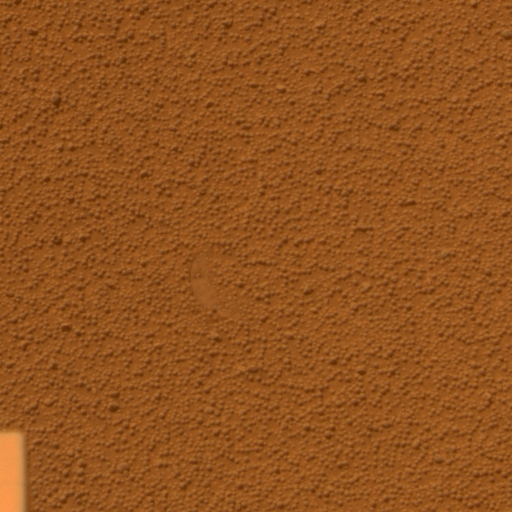
Ocean Watch (a soil on Mars) - field of view approximately 1/2 meter by 1/2 meter.
Photo credit: D. Savransky and J. Bell (Cornell) / JPL / NASA
Opportunity took this picture on Sol 2225 (martian day 2225) with its panoramic camera. This image is approximately true color, and shows a small impression where Opportunity’s instrument rested during the soil analysis.
Nothing has been released about the analysis of this soil yet – so your best guess about that texture is just great. Be the scientist – what do you think those “bubbles” are? Are they depressions or spheres? Are they hard? Soft? Are they just shapes in the sand that are easily disrupted or are they harder? Look at how they are different when they’ve been pressed by the instrument. Does that help you determine what they’re like? What might have caused them?
Using the microscopic imager Opportunity took a close up picture of the soil before deploying the “IDD” – the “Instrument Deployment Device” – also known as the arm.
Using the microscopic imager Opportunity took another close up picture of the soil AFTER deploying the arm. You can see where the instrument rested in the upper right of the picture. Some of the little bubbles or depressions are flattened, and others have been entirely squished.
Naming on Mars
If you follow the rover missions you’ll have heard of rocks and landforms on Mars named things like “Chocolate Hills,” “Concepcíon,” “Columbia Hills,” “Endurance,” or “Jenny.” Naming of objects in the solar system has to go through the International Astronomical Union (IAU), which can take years. In order to stay sane and not constantly have to say to each other “let’s take a look at that rock” or “shall we drive to crater 001-5BX?” the technicians and scientists working with the Mars rovers assign their own names to these items. Ocean Watch is such a name. I find it likely that many of these names will stick – having been used for years by the time the IAU has time to choose official names – but some will be changed, and some are of locations too small for anyone to care about once the rover has driven on. Ocean Watch is a very small patch of soil (about 1/4 of a square meter), so who knows what will happen.
For now though, a little patch of a distant planet holds a name that reminds us of the fragility of our own planet, and honors the excitement of doing science and science outreach.
Want More?
More information about this soil will eventually be posted in the MER Analyst’s Notebook.
Thank you, Amy.
![]()
~ A l i c e !
